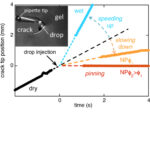Nanoparticles pin cracks in a proxy for living tissues
 A crack tip is a stress concentrator. Once initiated, it keeps on growing until it has released the whole available energy. A crack in a windshield is and example of a fracture that hardly stops and is stimulated by a wet environment. Biopolymer hydrogels have physico-chemical properties akin to that of soft living tissues, hence are widely used in biomedical applications (patches for drug release, scaffolds for tissue regeneration…). The physiological environment contains many nanoparticles in suspension (proteins, cells, inorganic colloid artefacts…). A team of INSP has shown that silica nonoparticles can interact with a crack very efficiently so as to prevent its growth.
A crack tip is a stress concentrator. Once initiated, it keeps on growing until it has released the whole available energy. A crack in a windshield is and example of a fracture that hardly stops and is stimulated by a wet environment. Biopolymer hydrogels have physico-chemical properties akin to that of soft living tissues, hence are widely used in biomedical applications (patches for drug release, scaffolds for tissue regeneration…). The physiological environment contains many nanoparticles in suspension (proteins, cells, inorganic colloid artefacts…). A team of INSP has shown that silica nonoparticles can interact with a crack very efficiently so as to prevent its growth.
Caption: The rate of crack growth in a hydrogel depends drastically upon the environment. Whereas pure water speeds up the crack, the latter is strongly slowed down by nanoparticles (NP) and even pinned on the spot if the concentration is large enough.
Reference
« Environmental Nanoparticle-Induced Toughening and Pinning of a Growing Crack in a Biopolymer Hydrogel »
O. Ronsin, I. Naassaoui, A. Marcellan, and T. Baumberger
Physical Review Letters,123, 158002 (2019)

